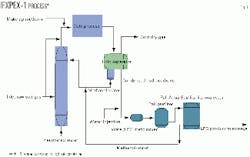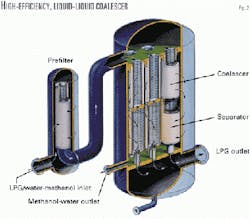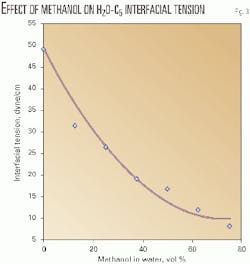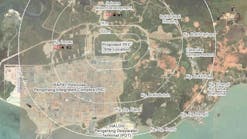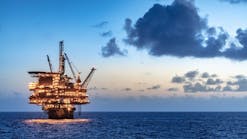A water wash has been found that effectively recovers the solvent in the IFPEXOL process by pulling dissolved methanol into water for subsequent removal.
The water-solvent mixture and hydrocarbon have a low interfacial tension that often forms a stable emulsion and is difficult to separate by conventional settling processes.
Effective separation of this emulsion and reuse of the methanol is critical in achieving optimum cost-effectiveness of the process.
IFPEXOL is a cryogenic liquids-separation process that uses methanol for dew point suppression instead of glycol. But the solvent losses resulting from the dissolution of methanol in the generated hydrocarbon liquids can be very costly.
The process
Developed by Institut Francais du Petrole, IFPEXOL is capable of dehydrating (IFPEX-1) and sweetening (IFPEX-2) sweet and sour natural gas and liquid streams.1 2
The IFPEX-1 process employs methanol instead of the commonly used triethylene glycol (TEG) to dehydrate the gas. This avoids the need for thermal regeneration of the solvent.
IFPEX-1 offers a number of benefits over glycol technology, including more compact design with only one contactor tower (good for offshore locations), no required heating, no foaming in contactors, reduced corrosion and solvent degradation, and the ability to locate the cold section at a separate treating location.
Fig. 1 shows a schematic of IFPEX-1, including the location for the advanced coalescer technology.
The inlet natural gas is first split into two streams. One, consisting of 50% of the total flow, passes through the IFPEX-1 contactor tower against rich methanol, while the remainder of the gas stream bypasses the tower.
The bypass stream and the IFPEX-1 contactor outlet stream are recombined, makeup methanol is injected, and the gas stream is then fed to a chiller. Condensation of the water phase and heavier hydrocarbons occurs during passage through the chiller.
The liquids are separated in the three-phase, low-temperature separator.
Gas flows to sales, while liquid hydrocarbons are further processed to produce LPG with a defined specification.
The heavy methanol, rich aqueous phase (75% MeOH) is recycled to the top of the IFPEX-1 contactor. As the gas rises in the contactor, the methanol is vaporized and stripped from the methanol-rich aqueous phase so that almost pure water is collected from the bottom of the IFPEX-1 contactor. The methanol is recovered by condensation in the cold process section.
The LPG can be further treated for additional methanol recovery with a mix tank and water-wash stage to recover soluble and carryover methanol from the LPG.
A high-efficiency polymeric liquid-liquid coalescer system is downstream of the water-wash stage to separate water-methanol-LPG emulsions formed in the washing stage.
The expected solubility of methanol in the LPG stream is 2,000 ppm under normal process conditions, and the methanol content can be much higher when free methanol and water are emulsified. Additional water extraction can be performed to recover this methanol.
The methanol-recovery process involves the mixing of water with the methanol-rich LPG stream to allow for sufficient mass transfer or extraction followed by a final separation stage that breaks the immiscible mixture into an organic and aqueous phase.
Once the methanol-extract water stream is separated, it is injected into the IFPEX-1 contactor. Based on solubility limits of the natural gas feeding the tower, the methanol is absorbed from the water into the gas while the stripped water is collected from the bottom of the tower.
It is possible that stable emulsions can be formed, depending on how the water-wash stream is contacted with the methanol-rich LPG.
Mixing tanks, contactor columns, or static in-line mixing devices can be used to increase the surface area of contact between the two phases and enhance extraction.
Often it is necessary to keep the size of the emulsified drops in the hundreds-of- micron size range so that separation can be successful with conventional separation devices, including gravity separators or mesh pad coalescers.
When the drop size created is in the micron size range, a stable emulsion forms that greatly enhances the extraction process by increasing the contacting surface area, allowing for a smaller overall extraction system.
The difficulty then lies in the separation of the stable emulsion, and this can be accomplished with advanced polymeric liquid-liquid coalescer technology.
Advanced technology
Traditional liquid-liquid coalescers have used glass fiber medium, which works well for emulsions that have interfacial tensions greater than 20 dyne/cm and for systems that have neutral water as the dispersed phase.
Pall Corp. has developed new coalescer media constructed with formulated polymers and fluoropolymers that are effective for emulsions having interfacial tensions as low as 0.5 dyne/cm and for harsh chemical environments.3 4
The Pall liquid-liquid coalescer has produced clean petroleum fuels with sodium levels less than 0.5 mg/l. and free water concentrations of less than 15 ppm (vol).
Fig. 2 shows a Pall AquaSep high-efficiency liquid-liquid coalescer in the vertical configuration.
The system consists of a prefilter section followed by a vertical stacked coalescer-separator cartridge stage that is a patented design of Pall.
The LPG and methanol-water emulsion first enters at the top of the coalescer housing and flows from the inside of the coalescer cartridges radially outward, causing the enlargement or coalescing of the inlet dispersion into large droplets at the outlet of the coalescer cartridges.
The aqueous coalesced drops and LPG then flow axially downward where the flow then goes from the outside of the separator to the inside.
The large coalesced drops are repelled by the separators and collected in the bottom sump.
The purified LPG passes through the separators and exits at the bottom of the housing.
Stages
The liquid-liquid coalescing system operates in three stages: separation of solids, coalescence, and separation of coalesced drops:
- Separation of solids. Solids can in crease the stability of an emulsion, and re moving solids can make coalescing easier.
Generally, this step can be achieved by a separate cartridge filter system or by a regenerable backwash filter system for high levels of solids. In addition, the filtration stage protects the coalescer and increases service life.
- Coalescence. In the next step in the process, primary coalescence, the pore dimensions begin with a very fine structure and then become more open to allow for void space for the coalescing droplets.
In the primary coalescence zone, the inlet droplet dispersion containing fine droplets in the size range of 0.2 to 50 mµ is transformed into a suspension of enlarged droplets in the size range of 500-5,000 mµ.
The coalescence mechanism involves adsorption of droplets to the coalescer fibers, followed by translation along the fibers, and collisions at the junctures between fibers. The collisions result in the droplets merging or coalescing, and the viscous drag of the bulk fluid stream then causes the enlarged drops to disengage from the fibers.
This process is repeated several times through coalescer depth until the large coalesced drops exit the coalescer medium.
The necessary condition that droplet-fiber adsorption occur for coalescing has been supported by a number of sources.5 6
- Separation of coalesced droplets. Once coalesced, the droplets are now assumed to be as large as possible for the given flow conditions. The separation stage is achieved with hydrophobic separator cartridges that provide an effective barrier to aqueous coalesced drops but allow the LPG to pass through them.
The methanol-water coalesced drops are carried with the downward convective flow of the LPG and accumulate in a lower collection sump. The purified LPG passes through the separators and exits at the bottom of the housing. The methanol-water in the collection sump can be manually drained periodically or equipped with an automatic level control and drain system.
Emulsion formation, stability
Emulsion formation and stability can be greatly affected by the addition of methanol.
Methanol acts as a surfactant and increases the solubility of the water in the LPG, thereby bridging the gap between the two immiscible fluids (LPG and water) and consequently strongly reduces the interfacial tension.
Pall Corp. conducted a study with pentane on the effect of methanol concentration in water on the interfacial tension (IFT). The study substituted pentane for LPG (propane-butane mixture) because it remains a liquid at atmospheric pressure.
Fig. 3 plots the IFT data showing the dramatic effect of increasing the methanol content on lowering the IFT, thereby making it more difficult to separate emulsions. These results were generated with high-purity chemicals and water. For real world systems, the IFT values will be even lower.
In addition to methanol, surfactants are present naturally in crude oil and, as a result, can make their way into refined petroleum products. Well-treating fluids and corrosion inhibitors used in gas pipelines can also act as emulsifiers.
Petroleum naphtha sulfonates are especially detrimental to conventional glass fiber coalescers.7 The surfactants can adsorb at the solid-liquid interface (coalescer fibers) or at the liquid/liquid interface (water/oil).
When surfactants concentrate on the coalescer fibers, this is known as "disarming," and the coalescer fibers are shielded from the passing aqueous droplets. This results in poor separation efficiency.
Generally, the disarming phenomenon does not occur unless the interfacial tension between the water and fuel is less than 20 dyne/cm. Disarming was not observed when specially formulated polymeric coalescer medium was used instead of glass fiber.3 4
The coalescing performance of a polymeric medium can be greatly enhanced by modification of surface properties, which cannot be accomplished with glass fiber medium.
Surfactants can also concentrate at the water-fuel interface, and this can lead to very small droplets and stable emulsions. Separating these types of emulsions requires special consideration applied to the pore size and distribution in the coalescer medium to intercept and coalesce the small droplets.
Brazeu River gas plant
Petro-Canada Oil & Gas operates the Brazeau River gas plant in Alberta. The plant processes a water-rich natural gas flow of 6,100 kg/hr (70 MMscfd) and a water-rich LPG flow of 38.5 kg/hr.
The IFPEX-1 process was selected so that the existing plant infrastructure could be utilized, even though the capacity of the new facility was 300% larger than the previous facility that utilized a conventional glycol configuration.
The initial start-up of the IFPEX unit went smoothly. Consumption of methanol was about 45 kg/hr, before the methanol-recovery technology was brought on-line. This methanol was leaving the system as a vapor in the natural gas sales stream and also in the LPG mix product due to solubility and entrainment caused by inefficient operation of the low-temperature separator.
The IFPEX-1 process for the Brazeau River gas plant was expected to have a methanol solubility of about 2,000 ppm in the LPG based on IFPEX operating experience elsewhere.
During the design phase of the Brazeau IFPEX unit, Petro-Canada anticipated the need for reduced methanol consumption to reduce the variable operating cost of the facility. Petro-Canada designed and added a methanol-recovery unit to the process for this reason.
Key to the success of the unit was installation of a high-efficiency polymeric liquid-liquid coalescer system to separate the emulsified methanol-water phase from the LPG mix product.
Petro-Canada determined that a water wash could effectively be used to extract the methanol in solution with the LPG mix. A simple water injector and mixer were used to raise the water content in the LPG mix to about 10%.
Subsequent removal of the water-methanol mixture would purify the LPG mix, but a viable technology would be needed to remove essentially all of the free water-methanol mixture from the LPG mix to meet product specification.
Conventional glass fiber liquid-liquid coalescing technology is known not to work under these circumstances because of the low interfacial tension of the water-methanol mixture in the LPG. Petro-Canada utilized high-efficiency polymeric liquid/liquid coalescer effectively to remove the water-methanol mixture from the LPG.
Alternative approaches that could be used to remove the methanol include the use of a wash tower instead of the injector and mixer previously described. The mixer was used due to the significantly lower capital cost.
Use of a tower would reduce the water load to the filters to a few hundred ppm but would not reduce the need for advanced coalescer technology to ensure that the LPG met product specification.
Plant coalescer operation
Petro-Canada installed a liquid-liquid coalescer system designed by Pall Corp. in 1996, that contained four, 20-in. long AquaSep coalescer cartridges and separators. In addition, a prefilter was installed to remove solid particulate from the LPG mix and precondition the emulsion for coalescing.
The methanol recovery and AquaSep liquid-liquid coalescer system installed in the Petro-Canada Brazeau River gas plant was able to reduce the aqueous-phase content of the LPG from as high as 20% down to 300 ppm total water. This reduction dropped the methanol consumption from 45 kg/hr down to 15 kg/hr.
Based on a methanol cost of $0.35/l. (Canadian), this represents a savings of more than $90,000/year for Petro-Canada, resulting in a payback time of less than 1 year.
The liquid-liquid coalescer system has been on-line for 2 years and has surpassed all expectations. Service life on the coalescers is more than 2 years, with four sets of prefilters being used annually.
References
- 1. Holcek, R.G., Minkkinen, A., and Larue, J., "The IFPEX-1 Process for Natural Gas Dehydration/Hydrate Inhibition-The North American Experience," Laurance Reid Natural Gas Conditioning Conference, Norman, Okla., 1996.
- Minkkinene, A., and Jonchera, J.P., "Methanol Simplifies Gas Processing," GPA 76th Annual Convention, San Antonio, March 1997.
- Brown, R.L., and Wines, T.H., "Improve Suspended Water Removal From Fuels," Hydrocarbon Processing, December 1993, Vol. 72, No. 12, p. 95.
- Wines, T.H., and Brown, R.L., "Difficult Liquid-Liquid Separations," Chemical Engineering, December 1997, Vol. 104, No. 12, p. 104.
- Jeater, P., Rushton, E., and Davies, G.A., "Coalescence in Fiber Beds," Filtration & Separation, March-April 1980, p. 129.
- Basu, S., "A Study on the Effect of Wetting on the Mechanism of Coalescence," Journal of Colloid and Interface Science, 1993, Vol. 159, p. 68.
- Hughes, V.B., "Aviation Fuel Handling: New Mechanism Insight into the Effect of Surfactants on Water Coalescer Performance," presented at the 2nd International Filtration Conference, San Antonio, April 1997.
The authors
Peter Hampton is a team leader in the Wildcat Hills development and operations group within Petro-Canada. He has been with the company for 19 years working in offshore drilling, offshore and land production operations, sour-gas plant operations, and sour-gas plant supervision. He holds a BSc (1978) in mechanical engineering from the University of Alberta and is a member of Association of Professional Engineers Geologists & Geophysicists of Alberta (APEGGA).
Thierry Darde is global marketing manager for the hydrocarbon business of Pall Corp., which he joined in 1995 as European marketing manager. He served as head of economics and scheduling at Shell's Berre refinery (1993-1995), plant manager for Shell's Reichstett refinery, (1989-1992) and was also a process engineer at the refinery (1987-1989). Darde holds a PhD and DsC in chemical engineering from Nancy University, France.
Robert H. James is vice-president, general industrial, for Pall (Canada) Ltd., Mississauga, Ont. He has also served as sales manager, industrial process; market sales manager, industrial process; marketing manager; and applications engineer. He holds a B Eng (1983) in mechanical engineering from McGill University, Montreal, and is a member of Professional Engineers Ontario and the Canadian Professional Sales Association (CPSA).
Thomas H. Wines is a senior marketing manager for the fuels and chemicals group at Pall Corp., East Hills, NY. He has also served as senior staff engineer, staff engineer, and senior test engineer in the scientific and laboratory services department. He holds a BS in chemistry from Fordham University and an MS in chemical engineering from Columbia University. He is completing studies for a PhD in chemical engineering at Columbia University. Wines is a member of AIChE and ACS.
